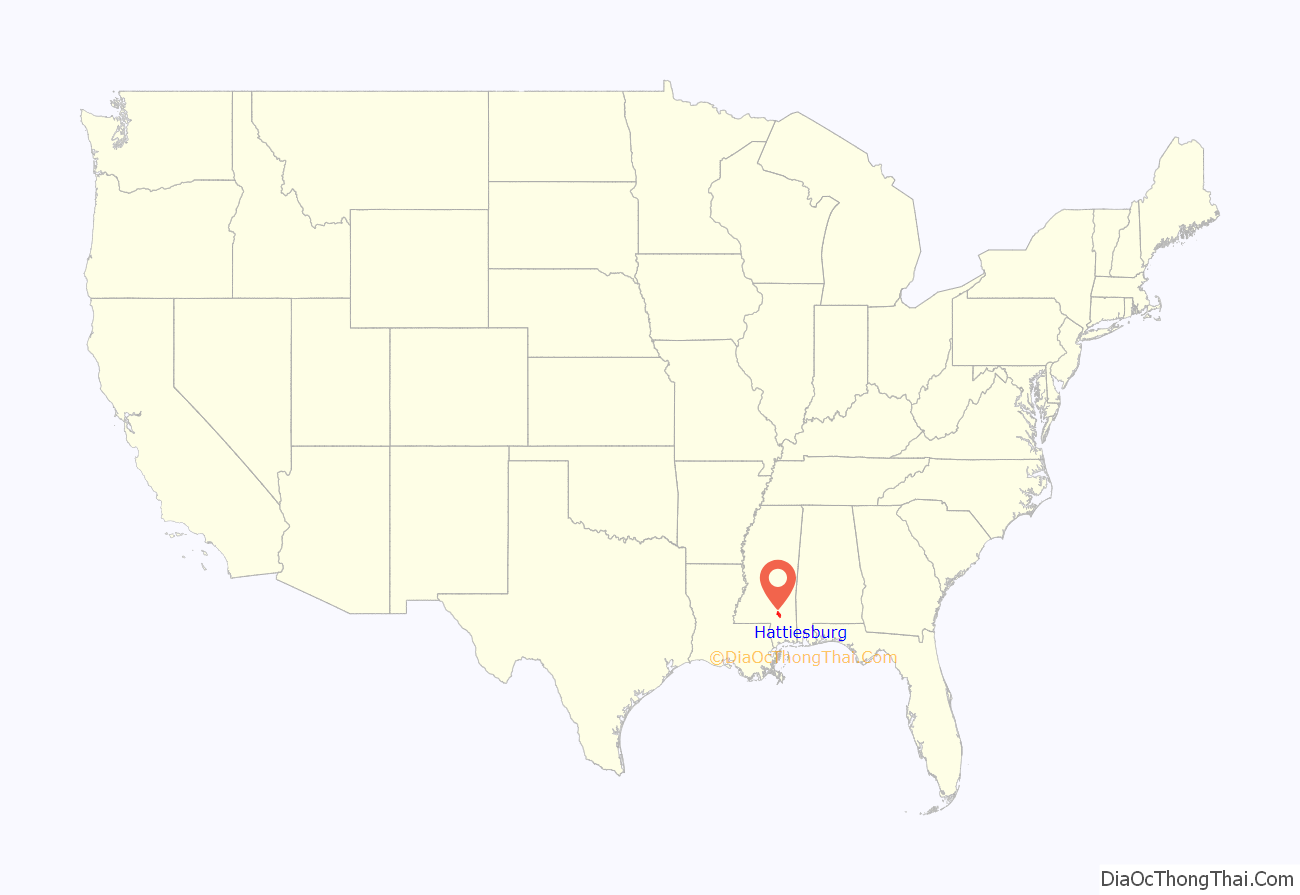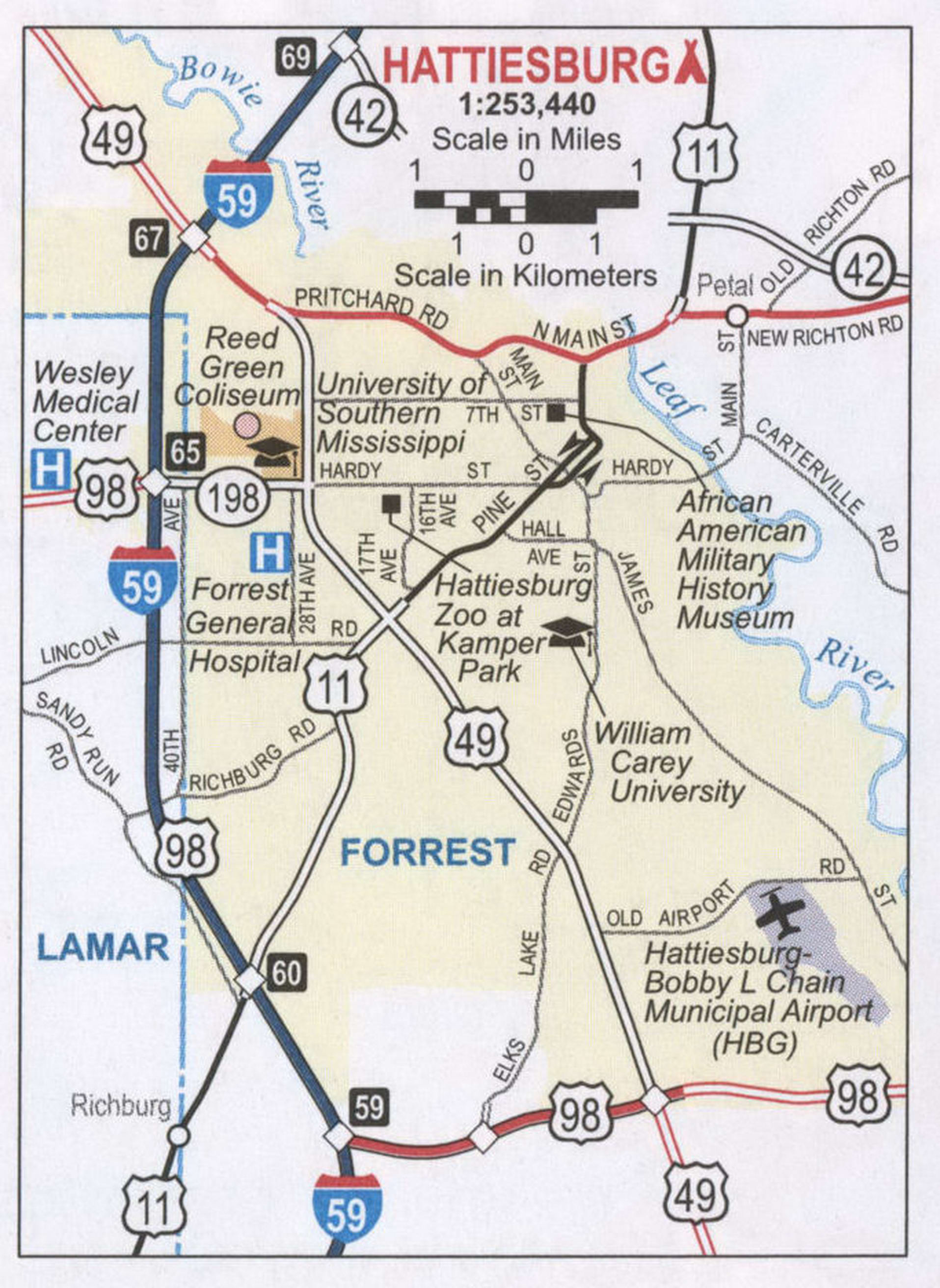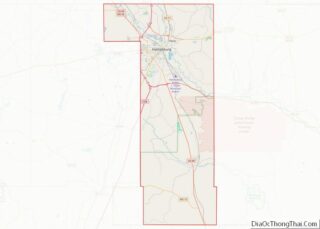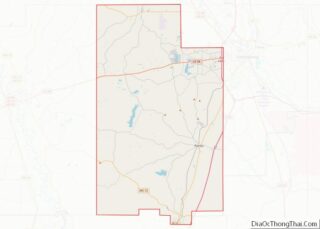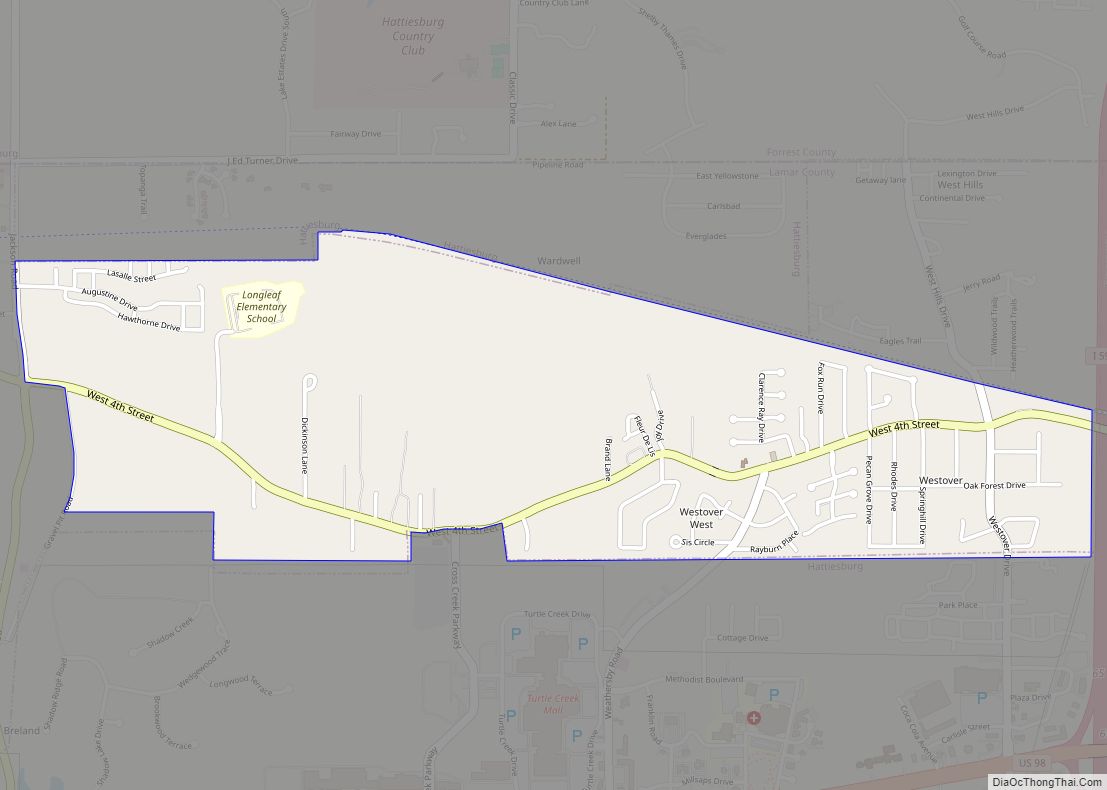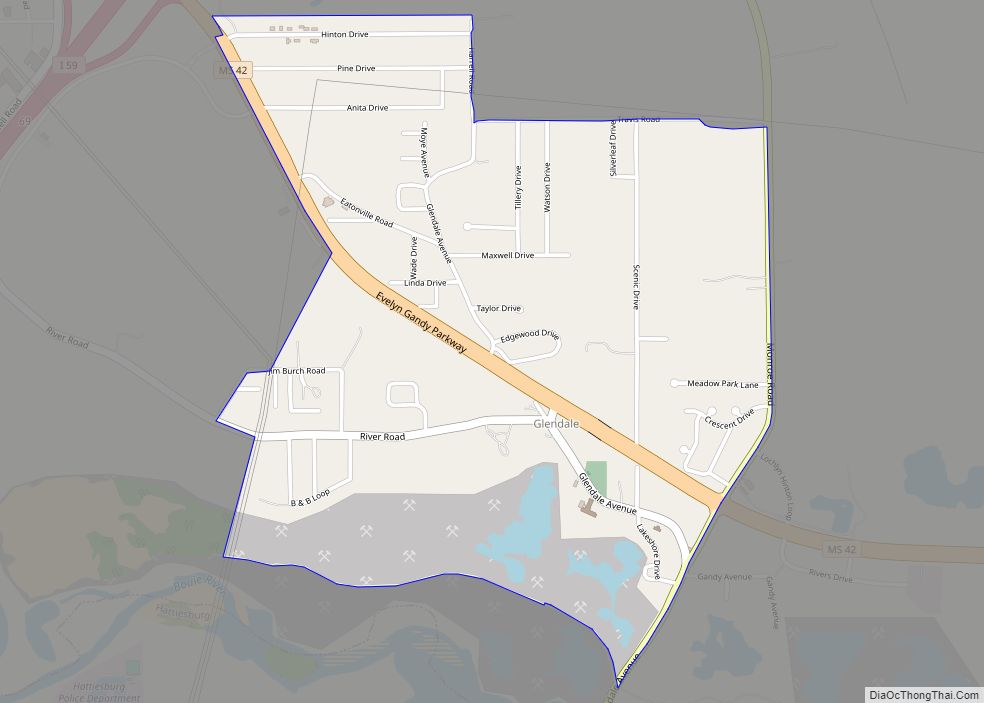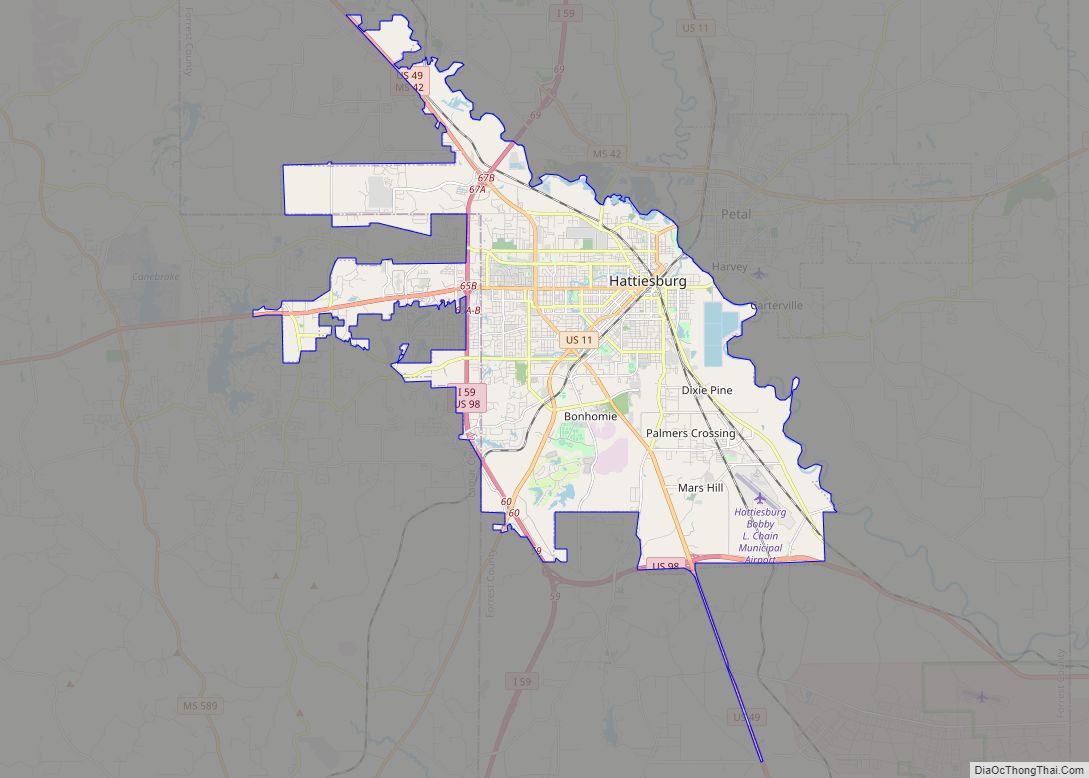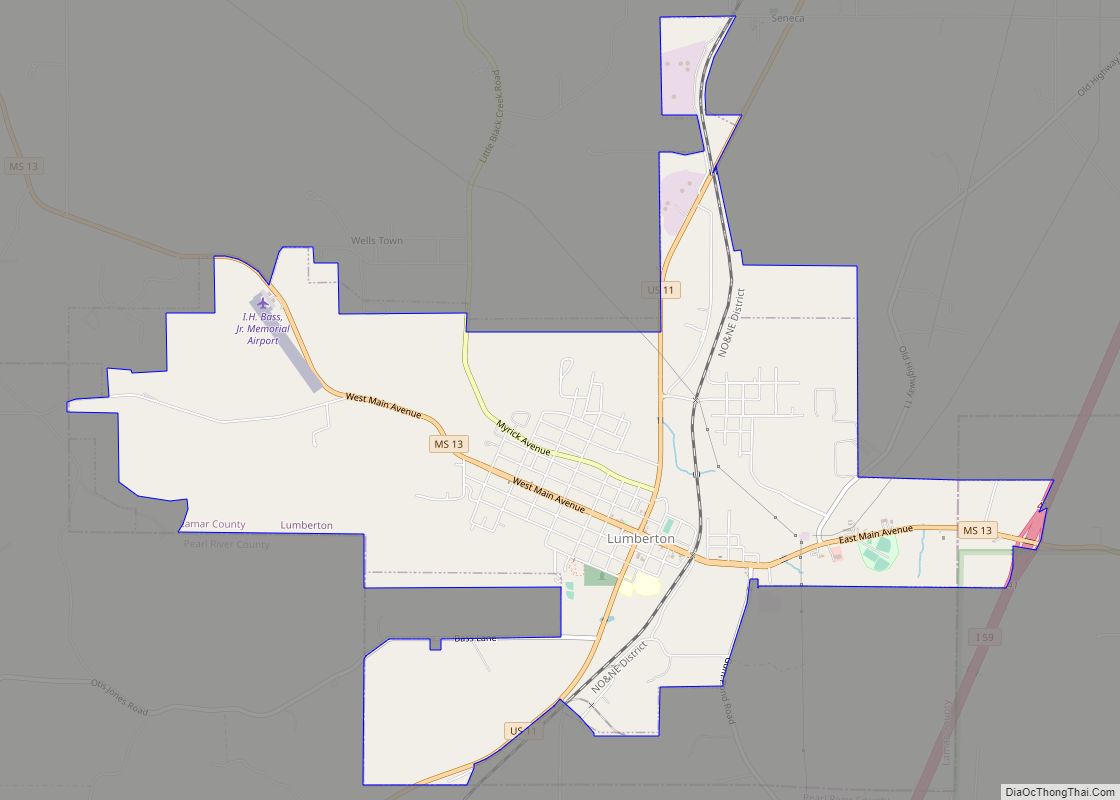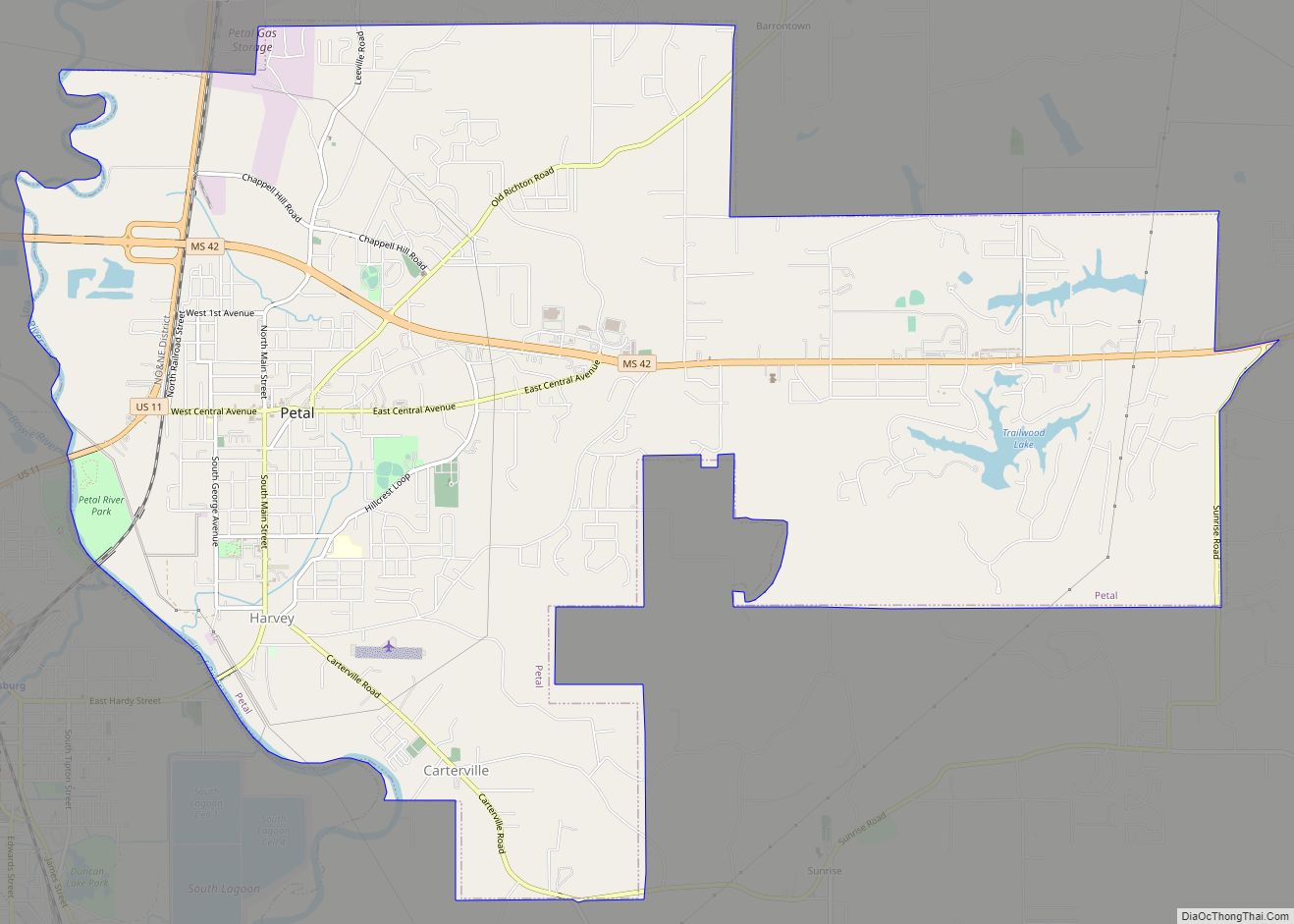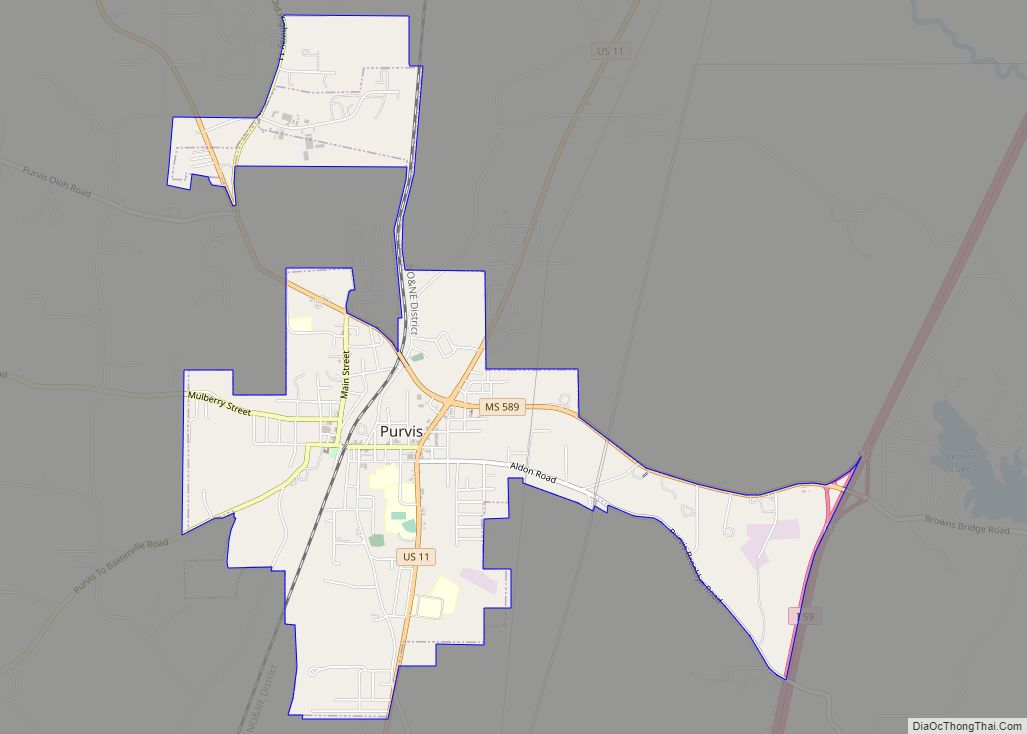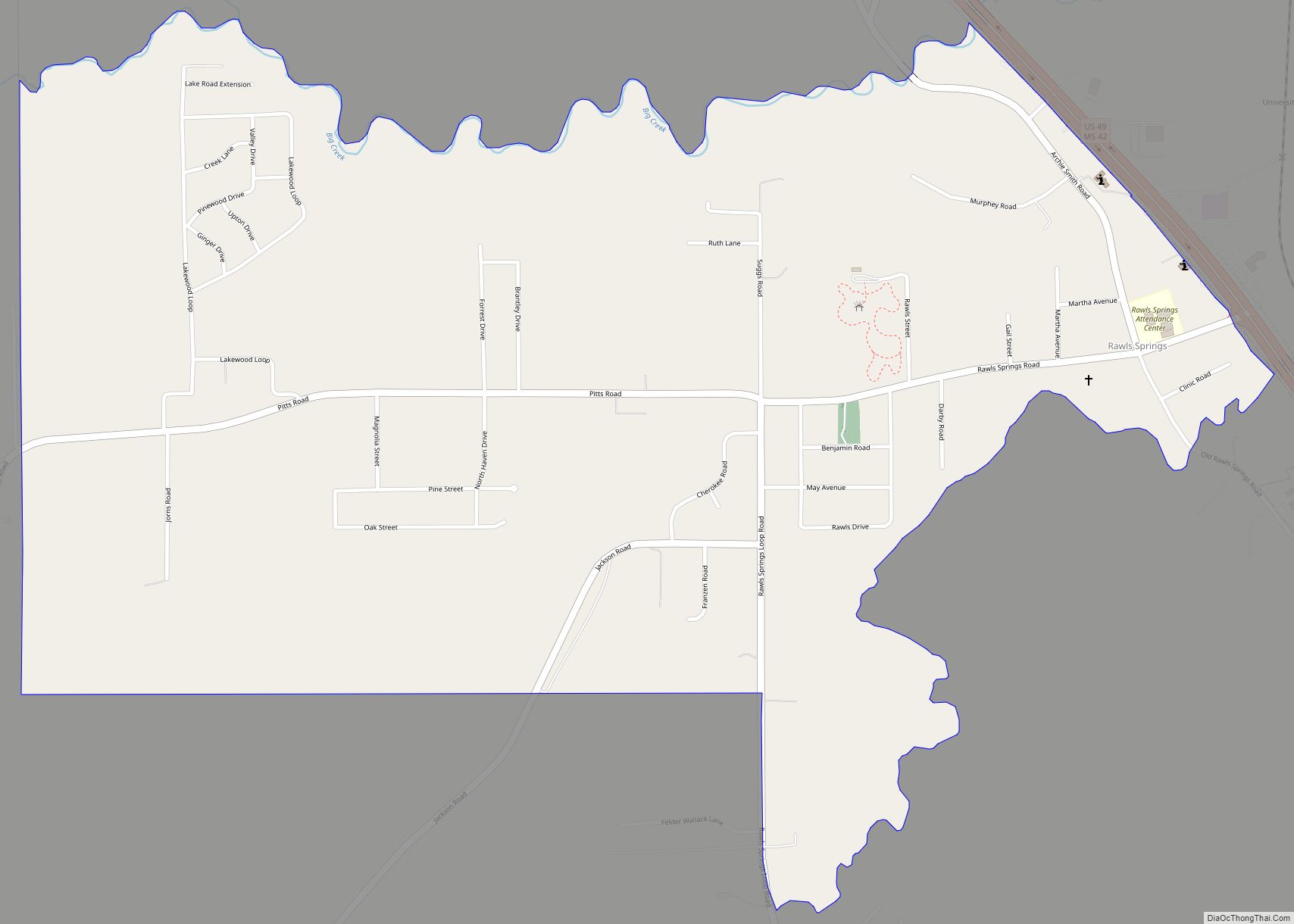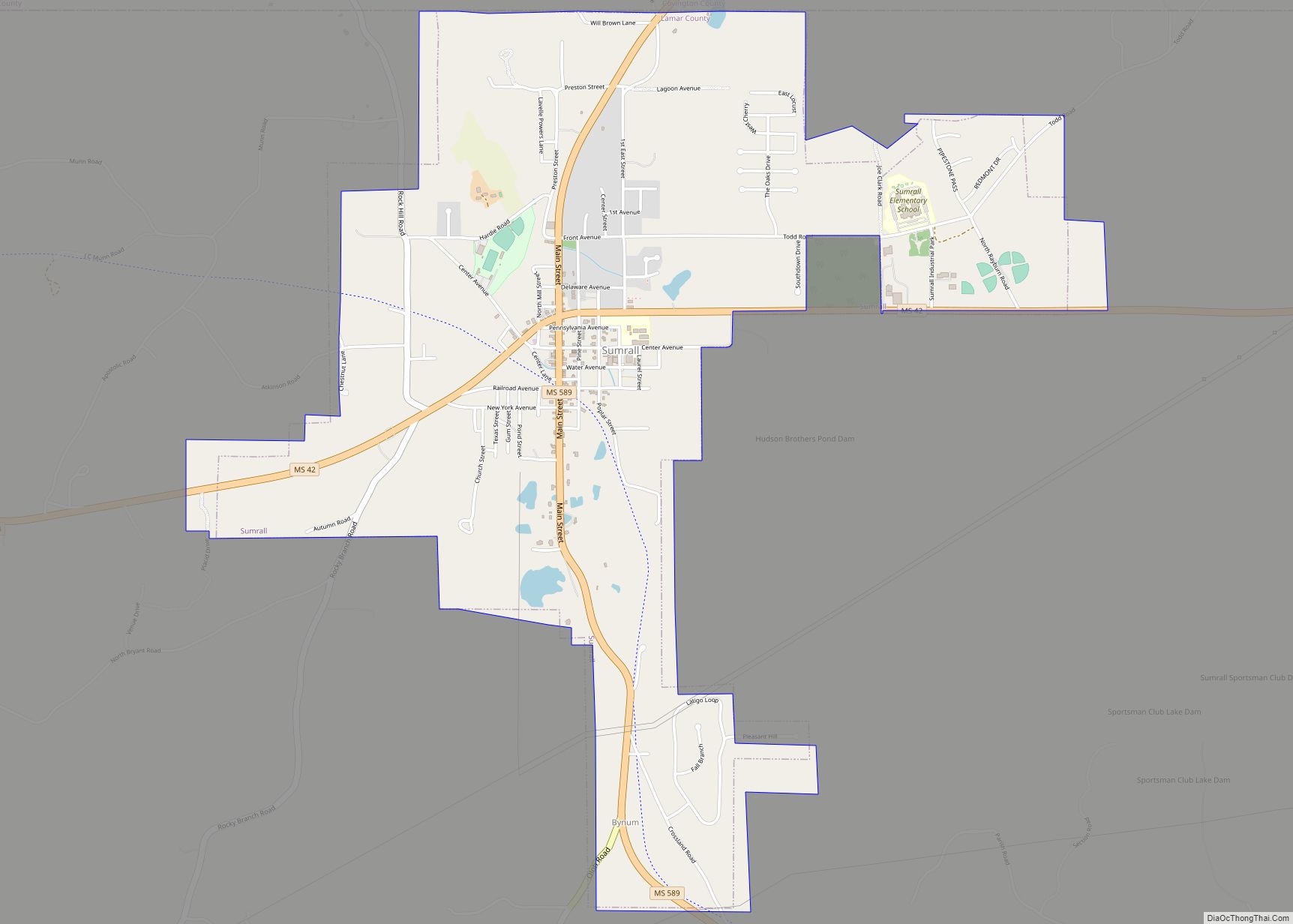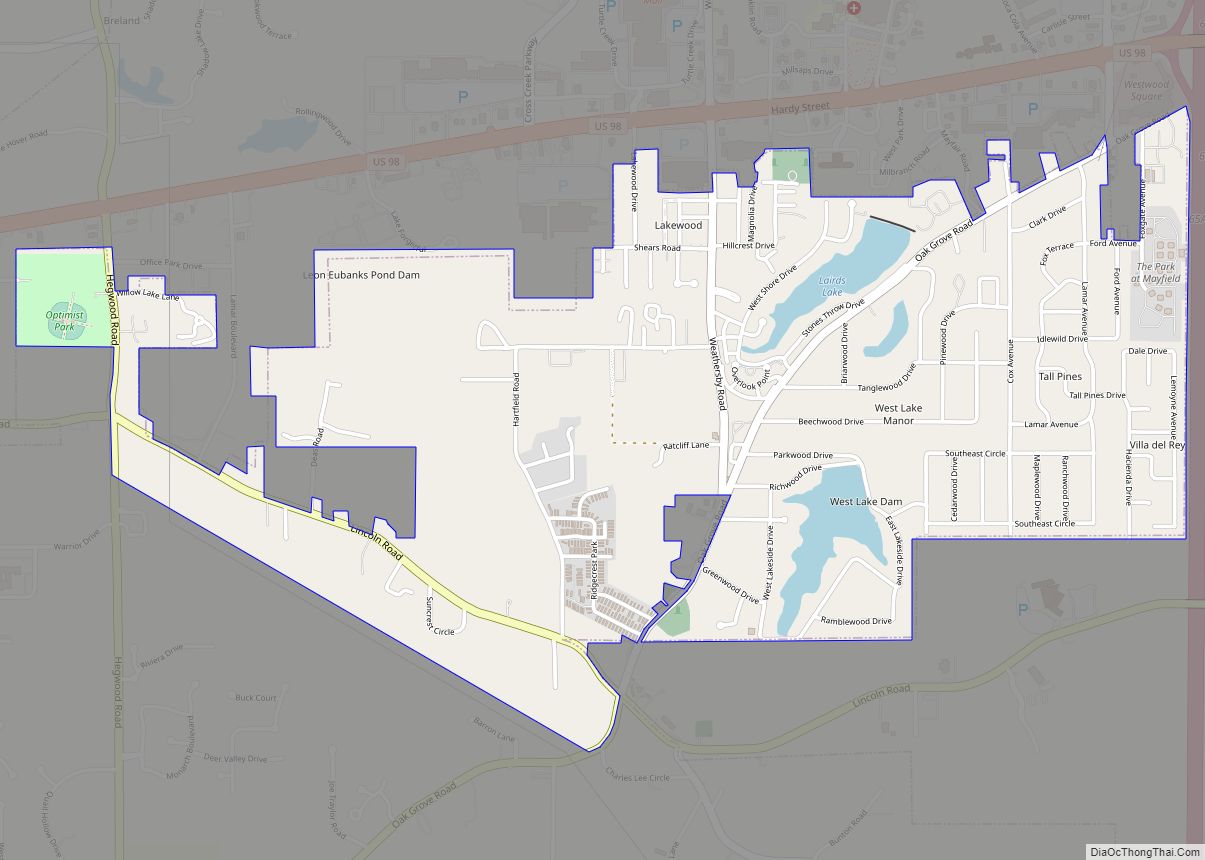Hattiesburg is a city in the U.S. state of Mississippi, located primarily in Forrest County (where it is the county seat and largest city) and extending west into Lamar County. The city population was 45,989 at the 2010 census, with the population now being 48,730 in 2020. Hattiesburg is the principal city of the Hattiesburg Metropolitan Statistical Area, which encompasses Covington, Forrest, Lamar, and Perry counties. The city is located in the Pine Belt region.
Development of the interior of Mississippi took place primarily after the American Civil War. Before that time, only properties along the major rivers were developed as plantations. Founded in 1882 by civil engineer William H. Hardy, Hattiesburg was named in honor of Hardy’s wife Hattie. The town was incorporated two years later with a population of 400. Hattiesburg’s population first expanded as a center of the lumber and railroad industries, from which was derived the nickname “The Hub City”. It now attracts newcomers because of the diversity of its economy, strong neighborhoods, and the central location in South Mississippi.
Hattiesburg is home to the University of Southern Mississippi (founded as Mississippi Normal College, for the training of teachers) and William Carey University (formerly William Carey College). South of Hattiesburg is Camp Shelby, the largest US National Guard training base east of the Mississippi River, which hosts up to 100,000 National Guardsmen and Reservists annually.
| Name: | Hattiesburg city |
|---|---|
| LSAD Code: | 25 |
| LSAD Description: | city (suffix) |
| State: | Mississippi |
| County: | Forrest County, Lamar County |
| Founded: | 1882 |
| Incorporated: | 1884 |
| Elevation: | 171 ft (52 m) |
| Land Area: | 53.44 sq mi (138.41 km²) |
| Water Area: | 1.04 sq mi (2.70 km²) |
| Population Density: | 911.85/sq mi (352.07/km²) |
| ZIP code: | 39401-39404, 39406, 39407 |
| Area code: | 601, 769 |
| FIPS code: | 2831020 |
| GNISfeature ID: | 0691565 |
| Website: | www.hattiesburgms.com |
Online Interactive Map
Click on ![]() to view map in "full screen" mode.
to view map in "full screen" mode.
Hattiesburg location map. Where is Hattiesburg city?
History
During European colonization, this area was first claimed by the French. Between 1763 and 1783 the area that is currently Hattiesburg fell under the jurisdiction of the colony of British West Florida. After the United States gained its independence, Great Britain ceded this and other areas to it after 1783. The United States gained a cession of lands from the Choctaw and Chickasaw under the terms of the Treaty of Mount Dexter in 1805. After the treaty was ratified, European-American settlers began to move into the area.
In the 1830s, the Choctaw and Chickasaw were relocated by United States authorities by treaties authorized by the Indian Removal Act, which sought to relocate the Five Civilized Tribes from the Southeast to west of the Mississippi River. They and their slaves were moved to Indian Territory in today’s Kansas and Oklahoma.
Hattiesburg developed at the confluence of the Leaf and Bouie rivers. It was founded in 1882 by Captain William H. Hardy, a civil engineer. The city of Hattiesburg was incorporated in 1884 with a population of approximately 400. Originally called Twin Forks and later Gordonville, the city received its final name of Hattiesburg from Capt. Hardy, in honor of his wife Hattie. Hattiesburg is centrally located less than 100 miles from the state capital of Jackson, as well as from the Mississippi Gulf Coast, New Orleans, Louisiana, and Mobile, Alabama.
In 1884, a railroad—known then as the New Orleans and Northeastern—was built from Meridian, Mississippi, in the center of the state, through Hattiesburg to New Orleans. The completion of the Gulf and Ship Island Railroad (G&SIRR) from Gulfport, to the capital of Jackson, Mississippi, also ran through Hattiesburg. It stimulated a lumber boom in 1897, with interior pine forests being harvested at a rapid pace. Although the railroad took 20 years to be developed, the G&SIRR more than fulfilled its promise. It gave the state access to a deep water harbor at Gulfport, more than doubled the population of towns along its route, stimulated the growth of the City of Gulfport, and made Hattiesburg a railroad center. In 1924, the G&SIRR operated as a subsidiary of the Illinois Central Railroad but lost its independent identity in 1946.
Hattiesburg gained its nickname, the Hub City, in 1912 as a result of a contest in a local newspaper. It was named because it was at the intersection of a number of important rail lines. Later U.S. Highway 49, U.S. Highway 98 and U.S. Highway 11, and later, Interstate 59 also intersected in and near Hattiesburg.
The region around Hattiesburg was involved in testing during the development of weapons in the nuclear arms race of the Cold War. In the 1960s, two nuclear devices were detonated in the salt domes near Lumberton, Mississippi, about 28 miles southwest of Hattiesburg. Extensive follow-up of the area by the EPA has not revealed levels of nuclear contamination in the area that would be harmful to humans.
Throughout the 20th century, Hattiesburg benefited from the founding of Camp Shelby (now a military mobilization center), two major hospitals, and two colleges, The University of Southern Mississippi and William Carey University. The growing metropolitan area that includes Hattiesburg, Forrest and Lamar counties, was designated a Metropolitan Statistical Area in 1994 with a combined population of more than 100,000 residents.
Although about 75 miles (121 km) inland, Hattiesburg was hit very hard in 2005 by Hurricane Katrina. Around 10,000 structures in the area received major damage of some type from the heavy winds and rain, as the hurricane tracked inland. Approximately 80 percent of the city’s roads were blocked by trees, and power was out in the area for up to 14 days. The storm killed 24 people in Hattiesburg and the surrounding areas. The city has struggled to cope with a large influx of temporary evacuees and new permanent residents from coastal Louisiana and Mississippi towns to the south, where damage from Katrina was catastrophic.
The City is known for its police department, as it was the first—and for almost a decade the only—Commission on Accreditation for Law Enforcement Agencies federally accredited law enforcement agency in the State of Mississippi. The department is served by its own training academy. It is considered one of the most difficult basic academies in the country, with a more than 50% attrition rate.
The Hattiesburg Zoo at Kamper Park is a longstanding tourist attraction in the city.
In 2011, the Hattiesburg Historic Neighborhood District was named one of the “Great Places In America,” to live by the American Planning Association. Places are selected annually and represent the gold standard in terms of having a true sense of place, cultural and historical interest. The twenty-five-block neighborhood has one of the best collections of Victorian-era houses in Mississippi, with more than ninety percent of the houses substantially renovated and maintained. The Hattiesburg Historic Neighborhood District [HHND] was Hattiesburg’s first recognized historic district and was listed on the National Register of Historic Places in 1980. It is also part of an Historic Conservation District and protected by Historic Hattiesburg Design Guidelines.
In 2013, the Hattiesburg Historic Neighborhood District celebrated the 38th Annual Victorian Candlelit Christmas and Holiday Tour of Homes. During the two nights of the Victorian Candlelit Christmas, thousands of candles burn in white bags lining the sidewalks. Christmas carolers from the three churches: Sacred Heart, Court Street Methodist, and Bay Street Presbyterian, stroll house to house singing Christmas music. Horse-drawn carriages carry visitors through the neighborhood at a walking pace.
The Miss Hospitality Pageant began in 1949. Hattiesburg was chosen in 1997 to sponsor the state pageant. The purpose of the pageant is the selection and presentation of a young, knowledgeable lady to help promote the state in tourism and economic development. Contestants are judged on the following categories: panel interview, one-on-one interview competition, Mississippi speech competition, commercial/black dress competition, and evening gown competition. The 2011 winner was Ann Claire Reynolds, a junior at University of Southern Mississippi who was majoring in elementary and special education.
Hattiesburg is home to the African American Military History Museum. The building opened as a USO club in 1942 to serve African Americans serving at Camp Shelby, as local facilities were racially segregated. It has been listed on the National Register of Historic Places. This building is the only remaining USO club site in the United States. It has been adapted for use as a museum interpreting African-American military history. Exhibits show their participation in all the major wars and the founding of Hattiesburg: exhibits include the Revolutionary War, Buffalo Soldiers, World Wars I and II, Desegregation, Korean War, Vietnam, Desert Storm, Global War on Terrorism, You Can Be A Soldier, Hattiesburg’s Hall of Honor, and World Map. The museum is dedicated to the many African-American soldiers who have fought for their country.
Civil rights movement
Hattiesburg and the unincorporated African-American community of Palmers Crossing played a key role in the civil rights transitions of the 1960s. In 1959, black Korean War veteran Clyde Kennard applied to attend then all-white Mississippi Southern College (today University of Southern Mississippi). He was denied admission because of his race, as state colleges were legally segregated. When he persisted, the newly formed Mississippi State Sovereignty Commission, a taxpayer-supported agency ostensibly set up to encourage tourism, allegedly conspired to have him framed for a crime. He was sentenced to seven years in Parchman Prison. For years, National Association for the Advancement of Colored People leaders Medgar Evers, Vernon Dahmer, and other Forrest County civil rights activists fought to overturn the conviction. The MSSC allegedly conducted outrageous activities against citizens of the state: it was claimed that agents investigated citizens, it created blacklists of activists and black professionals who were suspected of working for civil rights, it conducted economic boycotts against black-owned businesses, or arranged for blacks to be fired from state and local jobs. They reportedly also worked to have black activists or suspected activists evicted from rental housing. All of this was conducted in secret, until later allegations of revelations brought the state’s activities into the open.
Forrest County Registrar Theron Lynd prevented blacks in the area from registering to vote, based on such devices in the state constitution as poll taxes, and literacy and comprehension tests, subjectively administered by whites. In 1960, thirty percent of the population in the county was black, but less than 1% of blacks had been able to register, regardless of their education level. Registration by whites was close to 100%. In 1961, the U.S. Justice Department filed suit against Lynd. He was the first southern registrar to be convicted under the Civil Rights Act of 1957 for systematically violating African-American voting rights.
In 1962, the Student Nonviolent Coordinating Committee (SNCC) began one of its first voter-registration projects in Hattiesburg under the auspices of the Council of Federated Organizations (COFO). By 1964, the Delta Ministry was active in the city. In cooperation with the NAACP and local civil rights leaders, they formed the Forrest County Voters League. In conjunction with the 1963 elections, civil rights leaders organized a statewide Freedom Ballot, a mock election that claimed both the statewide pattern of voting rights discrimination and the strong desire of Mississippi blacks for the franchise. Despite the serious risk of both physical and economic retaliation, nearly half of Forrest County blacks participated, the highest turnout in the state.
January 22, 1964, was “Freedom Day” in Hattiesburg, a major voter registration effort supported by student demonstrators and 50 northern clergymen. For the first time since Reconstruction, an inter-racial protest was allowed to picket the courthouse for voting rights without being arrested. Roughly 100 African Americans attempted to register, though only a few were allowed into the courthouse due to (occupancy and space constraints) and fewer still succeeded in gaining entry on the rolls. Each day thereafter for many months, activists resumed the courthouse protest in what became known as the “Perpetual Picket.”
During Freedom Summer in 1964, the Hattiesburg/Palmers Crossing project was the headquarters for all civil rights activity in Mississippi’s 5th congressional district. This was the largest and most active site in the state, with more than 90 volunteers and 3,000 local participants. Hundreds of Forrest County blacks tried to register to vote at the courthouse, but blacks once again claimed without data that most were prevented from doing so. More than 650 children and adults attended one of the seven Freedom Schools in Hattiesburg and Palmers Crossing, three freedom libraries were set up with donated books, and a community center was established. It was alleged that “many” whites opposed civil rights efforts by blacks, and both summer volunteers and local African Americans endured arrests, beatings, firings, and evictions.
Forrest County was also a center of activity for the Mississippi Freedom Democratic Party (MFDP). It sent a slate of delegates to the National Democratic Convention in Atlantic City that year to challenge the seating of the all-white, pro-segregation delegates elected by the regular party in primaries from which African Americans had been largely excluded due to alleged voter registration barriers. Victoria Jackson Gray of Palmers Crossing ran on the MFDP ticket against incumbent Senator John Stennis, and John Cameron of Hattiesburg ran for Representative in the 5th District. With blacks not turning out to vote, these candidates knew they would not be elected, but their campaigns encouraged blacks to exercise their legal voting rights.
Even after passage of the federal Civil Rights Act of 1964 and the Voting Rights Act of 1965, resistance continued in Mississippi and Hattiesburg. On the night of January 10, 1966, the White Knights of the Ku Klux Klan reportedly attacked the Hattiesburg home of NAACP leader Vernon Dahmer with firebombs and gunfire. Dahmer was the most prominent black leader in the county and had been the primary civil rights leader for many years. Just prior to the attack, he had announced that he would help pay a $2 poll tax (equivalent to $17 in 2021) for black voters too poor to do so themselves. Dahmer held off the Klan with his rifle to give his wife, their three young children, and elderly aunt time to escape their burning home, but he died of burns and smoke inhalation the next day. His murder sparked large protest marches in Hattiesburg. A number of Klansmen were arrested for the crime, and four were eventually convicted. After four previous trials had ended in deadlocks, KKK Imperial Wizard Samuel Bowers was finally convicted in August 1998 for ordering the assassination of Dahmer. He was sentenced to life in prison.
In 1970, the U.S. Supreme Court ruled against trespass convictions of civil rights protesters in Adickes v. S.H. Kress Co.. The case involved a sit-in at the lunch counter of the S. H. Kress & Co. downtown.
Vela Uniform/Project Dribble nuclear tests
Vela Uniform was an element of Project Vela, conducted jointly in the 1960s by the United States Department of Energy and the Advanced Research Projects Agency. Its purpose was to develop seismic methods for detecting underground nuclear testing. The Project Dribble program involved two underground nuclear detonations. Test SALMON occurred on October 22, 1964, with a 5.3 kiloton yield; test STERLING was detonated December 3, 1966, with a yield of 380 tons. Both detonations took place within Tatum Salt Dome, southwest of the Hattiesburg/Purvis area.
Hattiesburg Road Map
Hattiesburg city Satellite Map
Geography
Most of Hattiesburg is in Forrest County. A smaller portion on the west side is in Lamar County, with abundant commercial land gained in a 2008 annexation. This consists of first, a narrow stretch of land lying east of I-59, and second, an irregularly shaped extension into West Hattiesburg. In the 2000 census, 42,475 of the city’s 44,779 residents (94.9%) lived in Forrest County and 2,304 (5.1%) in Lamar County.
According to the United States Census Bureau, the city has a total area of 54.3 square miles (140.6 km), of which 53.4 square miles (138.3 km) is land and 0.89 square miles (2.3 km), or 1.63%, is water.
Hattiesburg is 74 miles (119 km) north of Biloxi and 90 miles (140 km) southeast of Jackson, the state capital.
Geology and paleontology
Hattiesburg is situated on an outcrop of the Pascagoula and Hattiesburg formation which is thought to be Miocene in age. Miocene plant and animal fossils discovered from the vicinity of Hattiesburg indicate the area was once more swamp-like and dominated by low-growing palm trees.
Climate
Hattiesburg has a humid subtropical climate, with short, mild winters and hot, humid summers. Snowfall is extremely rare, but on December 11, 2008, areas around Hattiesburg received 3 to 5 inches (0.076 to 0.127 m). As is the case throughout the southern United States, severe thunderstorms can pose a threat, particularly during spring. Such storms spawn frequent lightning, heavy rain, occasional large hail, and tornadoes.
An EF4 tornado struck the Hattiesburg area on February 10, 2013, between roughly 5:00 p.m. and 5:30 p.m. CST. This tornado formed in Lamar County just west of Oak Grove and quickly increased in size and intensity. Although the most severe damage occurred in the Oak Grove area, especially near Oak Grove High School, the tornado continued eastward into Hattiesburg, causing widespread EF1-EF3 damage to the southern portion of the University of Southern Mississippi campus and the areas just north of downtown. It then moved into neighboring Petal and rural Forrest County. More than 80 injured were reported but no fatalities. The prevention of deaths was attributed to the nearly 30-minute lead time of the tornado warning.
The most recent tornado struck on January 21, 2017, when an EF3 hit the city early in the morning, killing four and injuring twenty. Some 10,000 people were left without power.
See also
Map of Mississippi State and its subdivision:- Adams
- Alcorn
- Amite
- Attala
- Benton
- Bolivar
- Calhoun
- Carroll
- Chickasaw
- Choctaw
- Claiborne
- Clarke
- Clay
- Coahoma
- Copiah
- Covington
- Desoto
- Forrest
- Franklin
- George
- Greene
- Grenada
- Hancock
- Harrison
- Hinds
- Holmes
- Humphreys
- Issaquena
- Itawamba
- Jackson
- Jasper
- Jefferson
- Jefferson Davis
- Jones
- Kemper
- Lafayette
- Lamar
- Lauderdale
- Lawrence
- Leake
- Lee
- Leflore
- Lincoln
- Lowndes
- Madison
- Marion
- Marshall
- Monroe
- Montgomery
- Neshoba
- Newton
- Noxubee
- Oktibbeha
- Panola
- Pearl River
- Perry
- Pike
- Pontotoc
- Prentiss
- Quitman
- Rankin
- Scott
- Sharkey
- Simpson
- Smith
- Stone
- Sunflower
- Tallahatchie
- Tate
- Tippah
- Tishomingo
- Tunica
- Union
- Walthall
- Warren
- Washington
- Wayne
- Webster
- Wilkinson
- Winston
- Yalobusha
- Yazoo
- Alabama
- Alaska
- Arizona
- Arkansas
- California
- Colorado
- Connecticut
- Delaware
- District of Columbia
- Florida
- Georgia
- Hawaii
- Idaho
- Illinois
- Indiana
- Iowa
- Kansas
- Kentucky
- Louisiana
- Maine
- Maryland
- Massachusetts
- Michigan
- Minnesota
- Mississippi
- Missouri
- Montana
- Nebraska
- Nevada
- New Hampshire
- New Jersey
- New Mexico
- New York
- North Carolina
- North Dakota
- Ohio
- Oklahoma
- Oregon
- Pennsylvania
- Rhode Island
- South Carolina
- South Dakota
- Tennessee
- Texas
- Utah
- Vermont
- Virginia
- Washington
- West Virginia
- Wisconsin
- Wyoming
